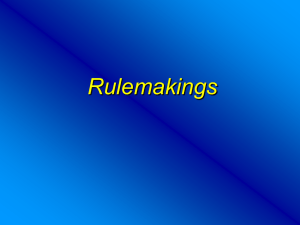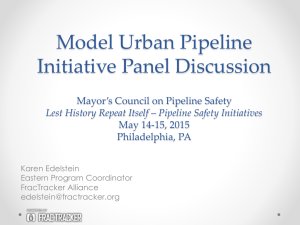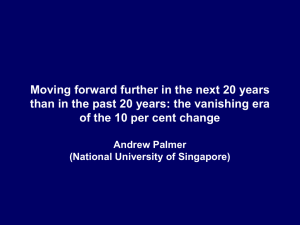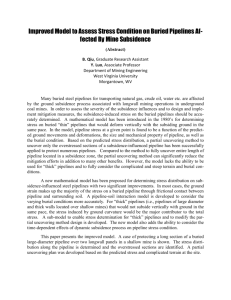INTEGRATING MODELING FOR PROFILE ANALYSIS
advertisement
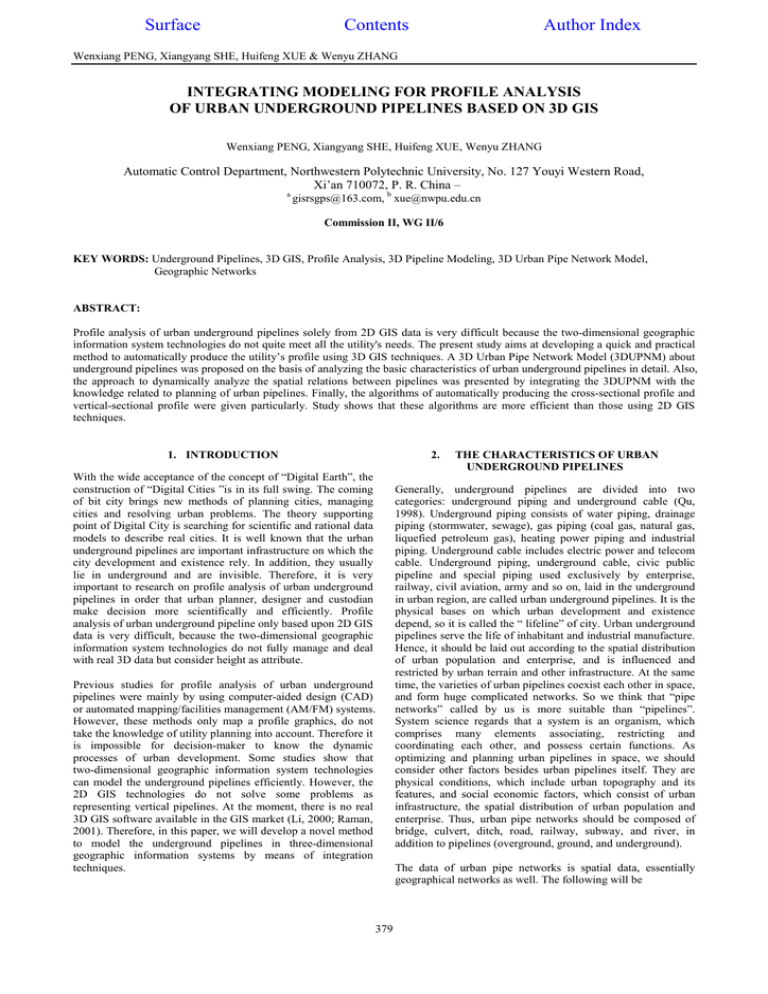
Surface
Contents
Author Index
Wenxiang PENG, Xiangyang SHE, Huifeng XUE & Wenyu ZHANG
INTEGRATING MODELING FOR PROFILE ANALYSIS
OF URBAN UNDERGROUND PIPELINES BASED ON 3D GIS
Wenxiang PENG, Xiangyang SHE, Huifeng XUE, Wenyu ZHANG
Automatic Control Department, Northwestern Polytechnic University, No. 127 Youyi Western Road,
Xi’an 710072, P. R. China –
a
gisrsgps@163.com, b xue@nwpu.edu.cn
Commission II, WG II/6
KEY WORDS: Underground Pipelines, 3D GIS, Profile Analysis, 3D Pipeline Modeling, 3D Urban Pipe Network Model,
Geographic Networks
ABSTRACT:
Profile analysis of urban underground pipelines solely from 2D GIS data is very difficult because the two-dimensional geographic
information system technologies do not quite meet all the utility's needs. The present study aims at developing a quick and practical
method to automatically produce the utility’s profile using 3D GIS techniques. A 3D Urban Pipe Network Model (3DUPNM) about
underground pipelines was proposed on the basis of analyzing the basic characteristics of urban underground pipelines in detail. Also,
the approach to dynamically analyze the spatial relations between pipelines was presented by integrating the 3DUPNM with the
knowledge related to planning of urban pipelines. Finally, the algorithms of automatically producing the cross-sectional profile and
vertical-sectional profile were given particularly. Study shows that these algorithms are more efficient than those using 2D GIS
techniques.
1. INTRODUCTION
2.
With the wide acceptance of the concept of “Digital Earth”, the
construction of “Digital Cities ”is in its full swing. The coming
of bit city brings new methods of planning cities, managing
cities and resolving urban problems. The theory supporting
point of Digital City is searching for scientific and rational data
models to describe real cities. It is well known that the urban
underground pipelines are important infrastructure on which the
city development and existence rely. In addition, they usually
lie in underground and are invisible. Therefore, it is very
important to research on profile analysis of urban underground
pipelines in order that urban planner, designer and custodian
make decision more scientifically and efficiently. Profile
analysis of urban underground pipeline only based upon 2D GIS
data is very difficult, because the two-dimensional geographic
information system technologies do not fully manage and deal
with real 3D data but consider height as attribute.
Previous studies for profile analysis of urban underground
pipelines were mainly by using computer-aided design (CAD)
or automated mapping/facilities management (AM/FM) systems.
However, these methods only map a profile graphics, do not
take the knowledge of utility planning into account. Therefore it
is impossible for decision-maker to know the dynamic
processes of urban development. Some studies show that
two-dimensional geographic information system technologies
can model the underground pipelines efficiently. However, the
2D GIS technologies do not solve some problems as
representing vertical pipelines. At the moment, there is no real
3D GIS software available in the GIS market (Li, 2000; Raman,
2001). Therefore, in this paper, we will develop a novel method
to model the underground pipelines in three-dimensional
geographic information systems by means of integration
techniques.
379
THE CHARACTERISTICS OF URBAN
UNDERGROUND PIPELINES
Generally, underground pipelines are divided into two
categories: underground piping and underground cable (Qu,
1998). Underground piping consists of water piping, drainage
piping (stormwater, sewage), gas piping (coal gas, natural gas,
liquefied petroleum gas), heating power piping and industrial
piping. Underground cable includes electric power and telecom
cable. Underground piping, underground cable, civic public
pipeline and special piping used exclusively by enterprise,
railway, civil aviation, army and so on, laid in the underground
in urban region, are called urban underground pipelines. It is the
physical bases on which urban development and existence
depend, so it is called the “ lifeline” of city. Urban underground
pipelines serve the life of inhabitant and industrial manufacture.
Hence, it should be laid out according to the spatial distribution
of urban population and enterprise, and is influenced and
restricted by urban terrain and other infrastructure. At the same
time, the varieties of urban pipelines coexist each other in space,
and form huge complicated networks. So we think that “pipe
networks” called by us is more suitable than “pipelines”.
System science regards that a system is an organism, which
comprises many elements associating, restricting and
coordinating each other, and possess certain functions. As
optimizing and planning urban pipelines in space, we should
consider other factors besides urban pipelines itself. They are
physical conditions, which include urban topography and its
features, and social economic factors, which consist of urban
infrastructure, the spatial distribution of urban population and
enterprise. Thus, urban pipe networks should be composed of
bridge, culvert, ditch, road, railway, subway, and river, in
addition to pipelines (overground, ground, and underground).
The data of urban pipe networks is spatial data, essentially
geographical networks as well. The following will be
IAPRS, VOLUME XXXIV, PART 2, COMMISSION II, Xi’an, Aug.20-23, 2002
Network elements
Network Links
Network Nodes
Stops
Centers
Turns
Barriers
Meaning
Representing the interconnected linear entities that are the conduits for transportation
and communication, such as the highways, water transmission lines
Endpoints and connecting point of network links, for instance well for examining and
repairing in utility network
Locations visited in a path or tour, such as bus stop
Discrete locations that have a supply of a resource or commodity
A transition from one network link to another at a network node
Network nodes which resources can not pass
Table 1. Main network elements of geographical networks
respectively analyzing their characteristics in geometry,
attribute, time, particularity and so on.
2.1
2.3
Urban pipe networks are always being modified according to
city development and alteration, widening of urban road. Hence,
urban pipe networks take on the peculiarity of dynamic change.
Matter, power, information stream flowing in urban pipe
networks is provided with this dynamic peculiarity yet. In order
to make certain rationally maxim sewage capacity which the
pumping station and sewage disposing factory should meet, it
must be considered that for sewage flux to vary with time in
certain pipe networks. According to the demand of Digital City,
urban pipe network information system should manage current
data and past data as well. Actually, it may supply rational data
of decision-making for city planing, constructing and managing
by analyzing current data and past data pertinent to urban pipe
networks. For example, we may find the sewage flooding
reasons of certain area by analyzing past data. Time
characteristics of urban pipe networks include the change of
their spatial location, shape, and attribute.
Geometric Characteristics
Urban pipe networks are artificial construction except the rivers.
It mostly includes pipeline, ditch and its attachment. In GIS, the
network data model can be used to model the pipe networks.
Network elements consist of network links, network nodes,
stops, centers, turns, barriers in terms of network data model
(table 1).It can be deduced from table 1 that network data model
is composed of network links and network nodes. In urban pipe
networks, the former is called pipe segments; the latter is called
the pipe points. For the sake of convenient, we mainly analyse
the geometric characteristics of piping (actually, urban pipe
networks mostly is composed of piping). In 3D Euclid space,
the geometric feature of pipe networks may be determined by
way of its pipe point locations (X, Y, Z), its diameter (generally
inner diameter), its wall thickness and the distance to ground.
Its diameter and wall thickness must meet engineering
specification in industrial fields; for instance, piping wall
thickness is 10% of its diameter. Thus, as far as a certain pipe
segment is concerned, its location in space (G) is confirmed in
terms of its end coordinate (X, Y, Z), its diameter (D), the
distance to ground (H). Its expression is shown in (1).
G = F ( X , Y , Z , D, H )
2.2
2.4
(1)
It is discovered that the attribute of urban pipe networks such as
material, diameter varies frequently (see figure 1). Apparently,
it is very difficult to manage the attribute data by means of the
conventional arc-node topological model. Therefore, the
dynamic segmentation technique should be employed in urban
pipe network domain (Peng, 2002).
Material
Diameter
Groundsill
Gradient
Time
Complicated Spatial Relation
Urban pipe networks interlace vertically and horizontally and
are fine as a cobweb. A pipe network is composed of piping
segments, constructing or buildings and its attachment. It
mostly unfold like tree, circularity or radial shape, and forms an
artificial system in which changing elements interact &
interface, any their change must make other relevant change of
that, and change of anyone may lead to entire system paralysis
finally. Because of the concealment of pipe networks, accident
location and its incidence are not made certain easily, it will
lead to the blindness of repair. If some kinds of pipe networks is
out of order in operating brings out the failure of other pipe
networks’ running. Therefore, urban pipe network information
system should deal with relations among the elements within a
pipe network and with other networks.
Attribute Characteristics
Pipe point
Time Feature
2.5
Meeting Engineering Specification
Layout of urban pipe networks should meet the engineering
specification. There is horizontal distance and vertical distance
limit between varied pipelines. The distance of pipe networks to
buildings (constructing) or to the ground should accords with
the engineering standard.
Pipe segment
Steel
Brick
Stone
RC
800mm
1000mm
500mm
0
180
1350 reinforced concrete
concrete
5‰
3‰
2‰
1985 year
2.6
Height Data
The calculating vertical distance between pipelines not only
needs height data, but also optimizing designs do. Thus, urban
pipe network information system should be capable of
managing and analyzing 3D data.
Figure 1. Variational attribute data for underground pipelines
380
Wenxiang PENG, Xiangyang SHE, Huifeng XUE & Wenyu ZHANG
called arc. Any arc is only relating to first node and last node in
it. Thus, data structure on the pipe points and pipe segment is
3. 3D URBAN PIPE NETWORK MODEL
CONCERNING TERRAIN
We should set up the spatial data model of urban pipe network
considering the characteristics of pipe network elements and
urban terrain together, from systems engineering view. The
problem, which mostly should be studied further in the
literature (Bai, 1997), is how to explore an approach to
integrating the analysis of geographical network with analysis
of terrain. It is proved that the urban terrain factor is very
important in the rational layout and design of the urban pipe
network. According to expression (1), it can be deduced that
five parameters are needed to make certain 3D spatial location
of urban pipe networks and the relationship relative to the
ground. The most of urban pipe network are buried in
underground; it is difficult to attain the distance H from pipeline
to the ground. We may make the height E of a ground point
corresponding to the random point in pipelines to take the place
of the distance H from pipeline to the ground. Thus, the
expression (1) is modified as (2).
G = F ( X , Y , Z , E, D )
Arc-id
Node-id
(2)
Other-Attribute
In order to provide it directly to decision-making supporting for
urban planning, designing, constructing and managing, it is
necessary that the above model is combined with the specialty
knowledge. For examples, minimum horizontal distance and
minimum vertical distance between pipelines, minimum
deepness under the ground and horizontal distance relative to
the building must meet the specification. Setting up spatial
database, we should turn above specification into constraint
rules. If the urban pipeline planning and designing meet it, the
planning and designing are rational, otherwise, the location and
elevation of pipelines will be adjusted automatically. For
example, if we build a sewage pipeline (P) which intersects gas
pipeline (R) below it in space, and border upon electric power
pipeline (L) and telecom cable (D) in horizontal direction.
According to the specification: minimum vertical distance
c>0.1m, minimum horizontal distance relative to electric power
pipeline s1>1.0, minimum horizontal distance relative to
telecom cable s2>0.5m, minimum deepness under the ground
H>0.7m. Thus, the constraint rule is shown in expression (5).
(3)
In order to set up uniform data model, we use the elevation of
random point in a pipeline zbi to take the place of Z and zti to
take the place of E. Therefore, the three-dimensional pipeline
domain (P) is shown in expression (4).
∧ ∃xi , y i , z bi , z ti ∈ P S , ∃d i ∈ P D }
X , Y, Zb,Zt
Other-Attribute
shown in figure 2. X, Y, Zb , Zt are regarded as spatial data in
our model, but height Z is regarded as attribute data in 2.5D
GIS model. It is out of question that we may describe vertical
pipelines using the model. From this model, it is very
convenient to know the spatial relation between pipelines, and
relations between ground and pipeline exactly. For instance, we
know the pipeline was located at underground if zti-zbi>0; If
zti-zbi<0, the pipeline is above the earth’s surface. Therefore, it
is very easy to manage the spatial relation among pipelines, and
the relation between pipeline and ground.
Form above analysis, it can be deduced that we may represent
spatial characteristics of pipe network, spatial relations between
pipelines, and relationship between pipelines and the ground
using five parameters including X, Y, Z, E and D in pipeline
domain P. So it is expressed as formula (3).
P SD = {P ( S + D ) | ∃i ,1 ≤ i ≤ ∞
Diameter
Figure 2. Logical model of 3DUPNM
Where E= the height of ground point corresponding to the
random point in pipelines.
P = F ( X ,Y , Z , E, D)
Fnode Tnode
(4)
∀P(c(P, R) > 0.1) ∧ (s1(P, L) >1.0)
∧ s2 (P, D) > 0.5 ∧ (H > 0.7)
Where
P = three-dimensional pipeline domain
S = extended spatial domain
zbi = altitude of pipelines
zti = the ground altitude related to point (xi, yi, zbi)
D = pipeline diameter domain
(5)
By the same reasoning, all specification may be expressed
restricting condition in order to plan pipeline networks in 3D
space. If the value of expression (5) is true, it indicates that the
pipeline planning and designing is rational, otherwise,
dynamically adjust the location (X, Y, Z) of pipelines.
The data model integrates the element characteristics of pipe
network with the terrain factor, and formularizes in 3D space.
Thus, we call it 3D urban pipe network model (3DUPNM).
4. PROFILE ANALYSIS OF URBAN UNDERGROUND
PIPELINES
It is well known that we may apply the field model and object
model to express geographic model. The field model is fit for
the continuous space, and object model is fit for the discrete
space. In terms of object-oriented thought, the chief spatial
object corresponding to the urban pipe networks is the pipe
points and pipe segments. The former is called nodes; the latter
The organization of pipeline information and its specific form
have a close relationship with the relative management. The
previous pipeline information is represented by the way of
two-dimension on the map, which characterize the tendency
direction of pipeline. It is difficult to present clearly and
381
IAPRS, VOLUME XXXIV, PART 2, COMMISSION II, Xi’an, Aug.20-23, 2002
correctly the there-dimensional information of the deepness and
the diameter of pipeline. The profile graphics and diagrams,
however, can preferably represent both the spatial relationship
among types of pipelines and the deepness from the pipelines to
the ground. According to the 3D data model of urban pipe
network considering city terrain factor, we dynamically can not
only figure the location relative to other infrastructure, but
automatically produce the profile graphics of random location
in pipelines. The profile graphics consist of cross section, which
intersects the underground pipelines, and vertical section, which
is along the pipelines. The algorithms above producing
cross-sectional profile are as follows.
5. DISCUSSIONS AND CONCLUSIONS
An approach to dynamically analyze the spatial relationships
between pipelines was presented by integrating the 3DUPNM
with knowledge related to planning of urban pipelines. Also, a
method to automatically produce cross-sectional profile and
vertical-sectional profile was presented by means of integrating
3D GIS with the knowledge related to planning of underground
pipelines in order to overcome the shortcomings which the
conventional 2D GIS faces in modeling the 3D linear features.
In the further research, we’ll take linear referencing or dynamic
segmentation techniques and temporal dimension into account
in our 3DUPNM. As a result, the model has been placed in
“Urban Pipeline Decision Support System” produced by the
project entitled: “Three-Dimensional Urban Pipeline
Information System”, funded by Xi’an municipality, P.R. China.
The practice shows that the model not only displays the
pipelines’ relationships efficiently, but also meets the local
decision maker’s needs.
Step 1:
Step 2:
Encoding of pipeline and road data.
Automatically building of topological relations of
pipelines.
Step 3: Drawing random profile line AB.
Step 4: Calculating the coordinate of intersection point
between AB line and pipelines.
Step 5: Checking the pipeline data, if the data is entire,
then next step, or step 10.
Step 6: Calculating the height of intersection points and
ground point corresponding to pipelines by
interpolating.
Step 7: Drawing profile according to pipeline type.
Step 8: Drawing ground elevation line according to
the distance to A point.
Step 9: Labeling and ornamenting graphics.
Step 10: End.
ACKNOWLEDGEMENTS
This research was funded by Xi’an municipality, P.R. China under project
No.: GG200113 entitled: “Three-Dimensional Urban Pipeline Information
System”.
REFERENCES
The steps of drawing the vertical-sectional graphics are as
follows.
Step 1:
Step 2:
Step 3:
Step 4:
Step 5:
Step 6:
Step 7:
Step 8:
Step 9:
Step 10:
Step 11:
Step 12:
Step 13:
Step 14:
Bai, L., 1997. The Research and Practice on Geographic Network Analysis.
Ph.D. Thesis. Institute of Surveying and Mapping.
Encoding of pipeline and road data.
Automatically building of topological relations of
pipelines.
Selecting pipeline segment.
Checking the pipeline data, if the data is entire,
then next step, or step 14.
Searching for opening segment (suppose first node
is A).
Searching for next segment by using topological
relation.
Drawing ground height line according to Zti value.
Drawing pipeline bottom height line according to
Zbi value.
Drawing pipeline top height line according to Zbi
and pipe diameter value.
Drawing well line at the ends.
Calculating the coordinate of intersection point
between selection pipe segment and other pipeline,
its Zbi and horizontal distance relative to A point
by means of interpolating.
Drawing pipeline section according to pipeline type.
Labeling and ornamenting graphics.
End.
Li, Q.Y., Lin, Z.J., Li, C.M., 2000.The Status and Development of 3D GIS
Study, Science of Surveying and Mapping, 25(2), pp. 47-51.
Peng, W.X., Xue, H.F., Zhang, H.,C., Li, X.N., 2002. Spatial Database for
City Distribution Networks Based on Dynamic Segmentation, Journal of
Northwest University, 32(1), pp. 97-100.
Qu, F.B., 1998. Technology and Practice on Surveying the Urban
Underground Pipelines. Publishing House of Southeast University, Nanjing,
China, pp.23 –34.
Raman, A. A., Zlatanova, S., Pilouk, M., 2001. The 3D GIS Software
Development: Global Efforts from Researchers and Vendors,
Geoinformation Science Journal, 1(2).
Because the above algorithms integrate the characteristics of
terrain with those of the underground pipelines from 3D GIS,
the methods of profile analysis are more efficient than those
using 2D GIS techniques. From the profile map we can query
the altitude at any location and intersection pipeline information
such as material, diameter. So this is not only a map, but also an
information system, which can produce profiles and manage the
pipeline’s relations each other. Not only does meet the practical
needs, but also dynamically manage the information of the
profile map.
382

